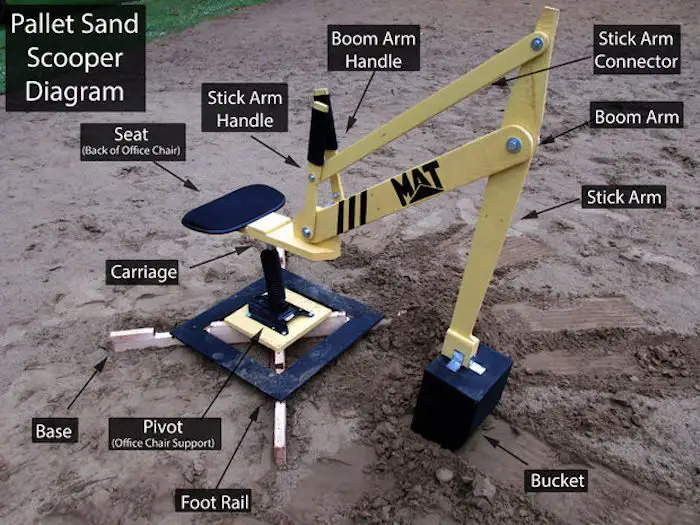
If you have a sandbox in your backyard, this little toy will make playtime more fun! Look at this great and fun idea to build for your kids – the DIY toy excavator for sandbox.
It may seem quite a lot of woodwork to build this. But really, it’ll take about a day, or perhaps two. This could be a weekend project for you. While you’re at it, ask your child to help out even with just the most basic tasks. It will be a great bonding activity.
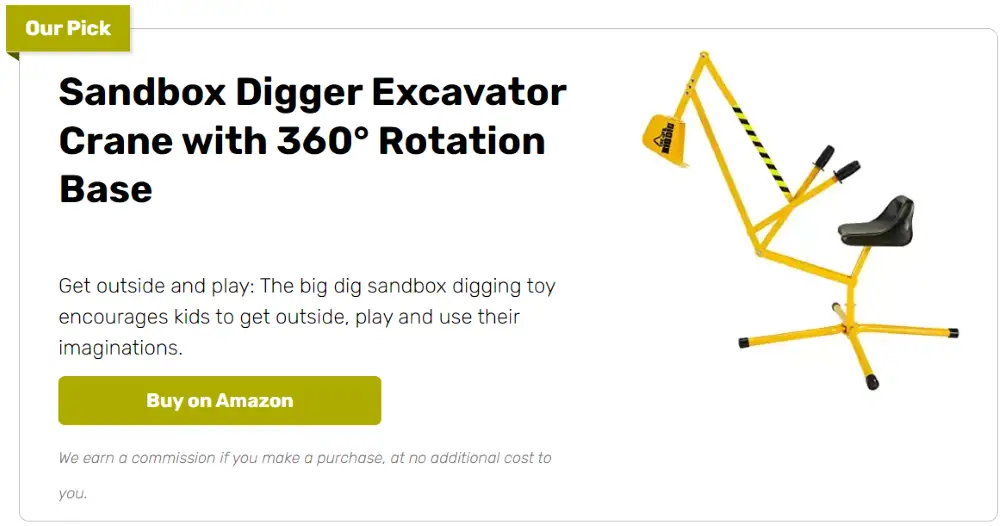
With only a few wooden pallets, nails, glue, and time, any parent can assemble this great toy. It’ll keep any kid entertained. If you don’t have a sandbox to use this with, maybe you can build one, too! It beats having them watch TV all day.
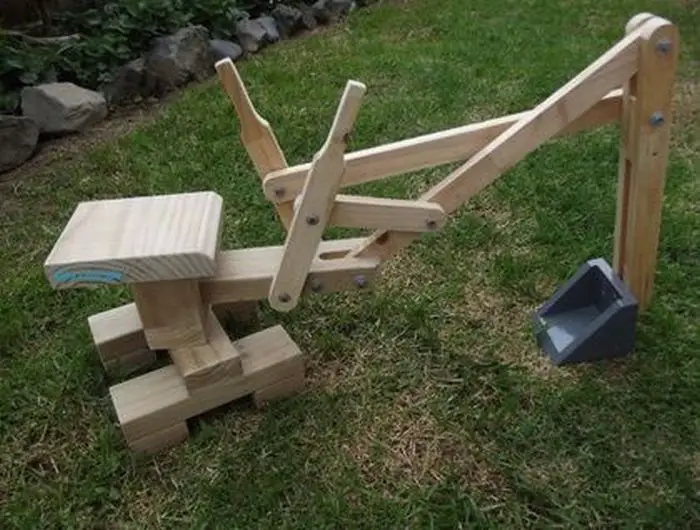
Let’s get some woodwork done and build something our kids can enjoy at the sandbox.
Contents
How to Make a Toy Excavator for Sandbox
You’ll need these materials:
- 1 – 2 pallets (heat treated)
- 3/4″ galvanized pipe flange
- 12″ length of 3/4″ threaded galvanized pipe
- Three 1″ L brackets
- Waterproof Wood Glue
- Cheap office chair
- Assorted lag screws and bolts
- Paint (color of choice)
- Cording (optional)
- Coil spring (optional)
And these tools:
- Wood clamps
- Circular saw
- Hand drill
- Band saw
- A set of wrenches
- Table saw
Too complicated? There are simpler designs you can follow. Check them out below…
‘Click on any image to start lightbox display. Use your Esc key to close the lightbox. ?’

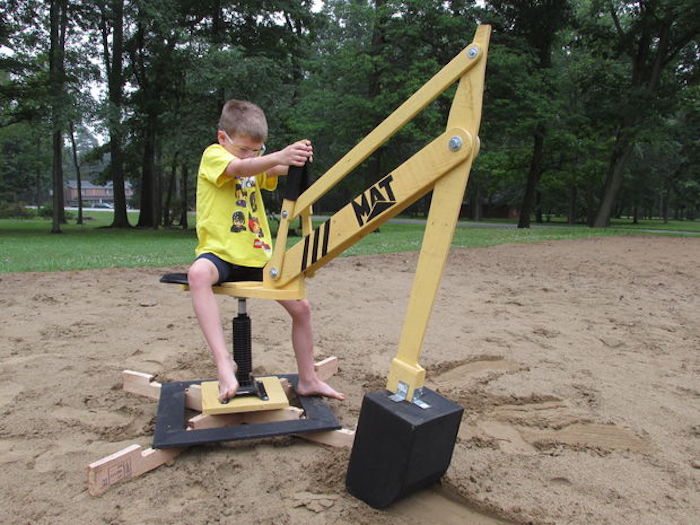
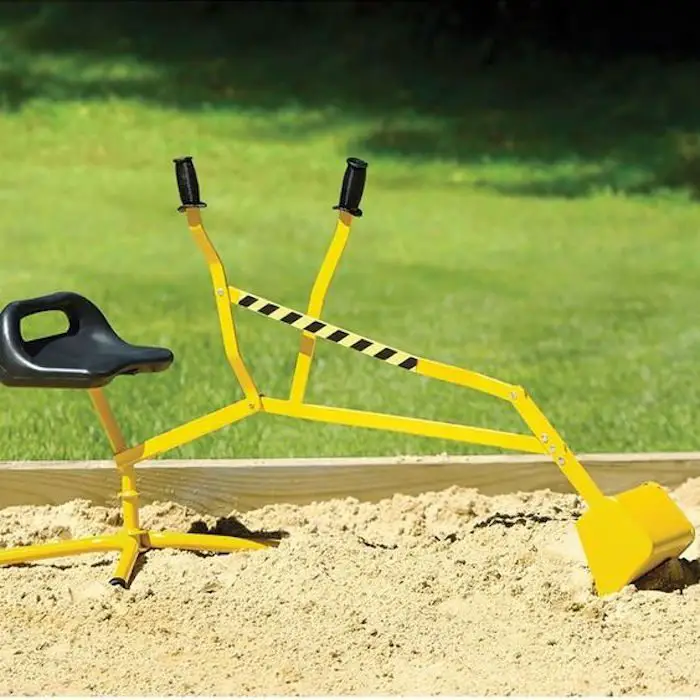
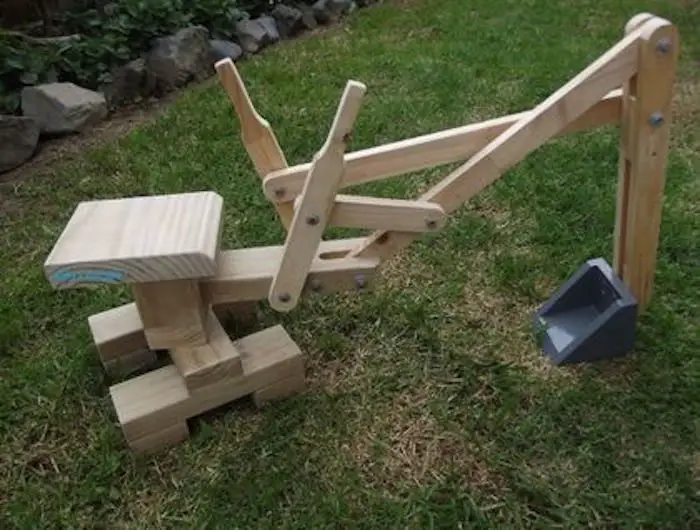
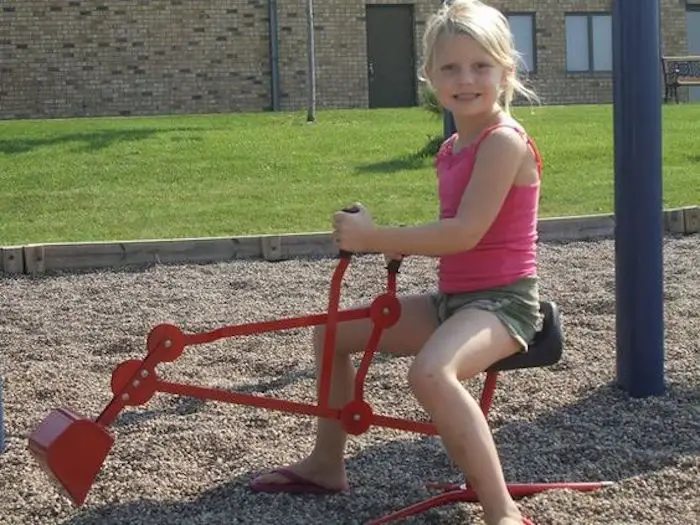
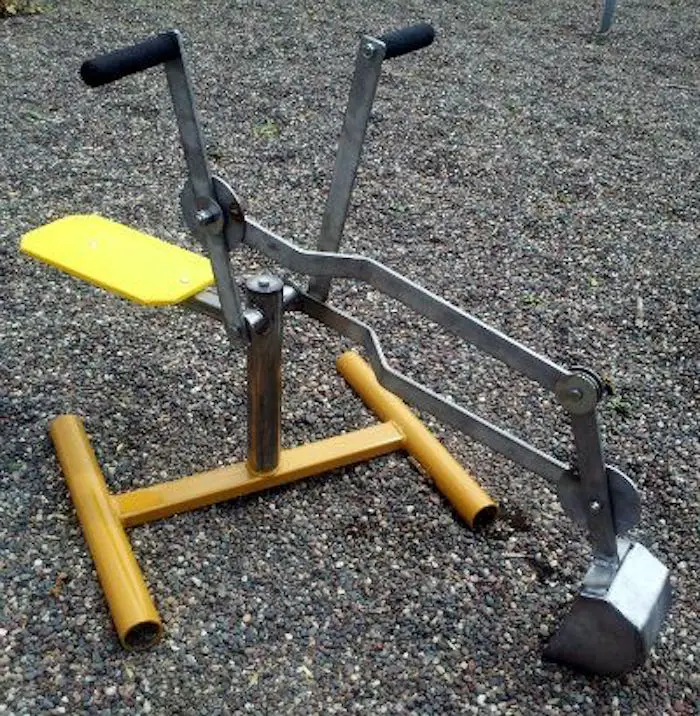
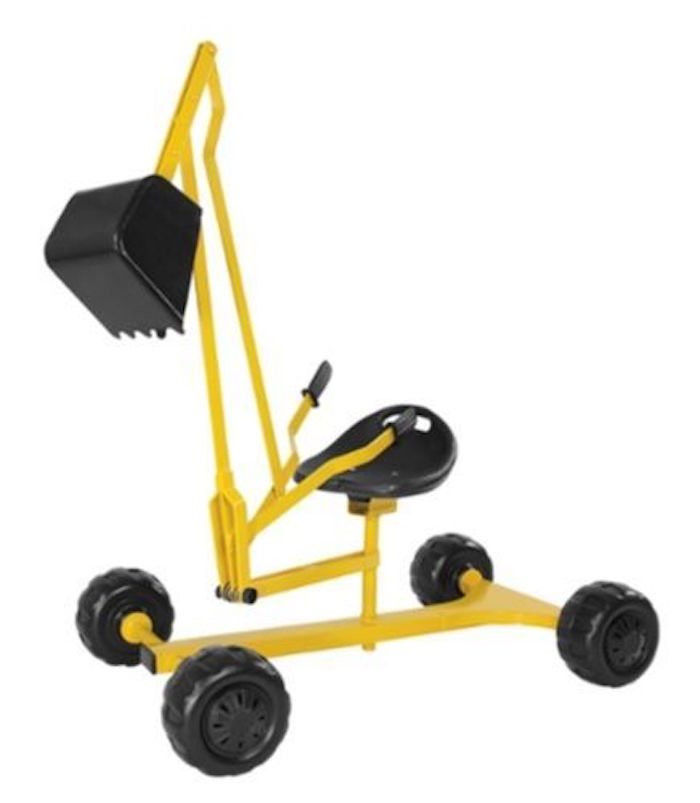

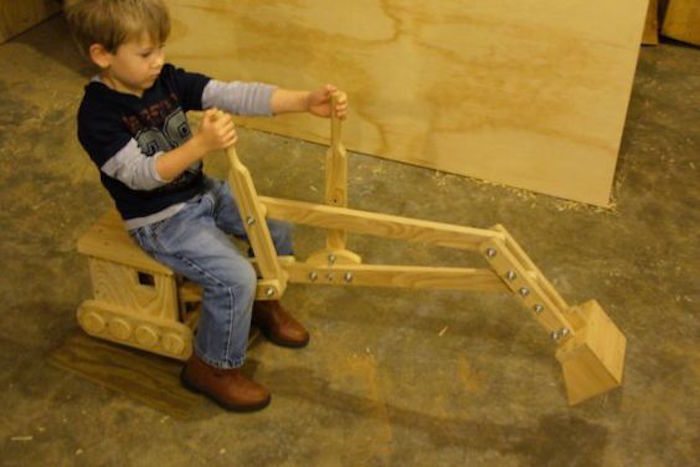
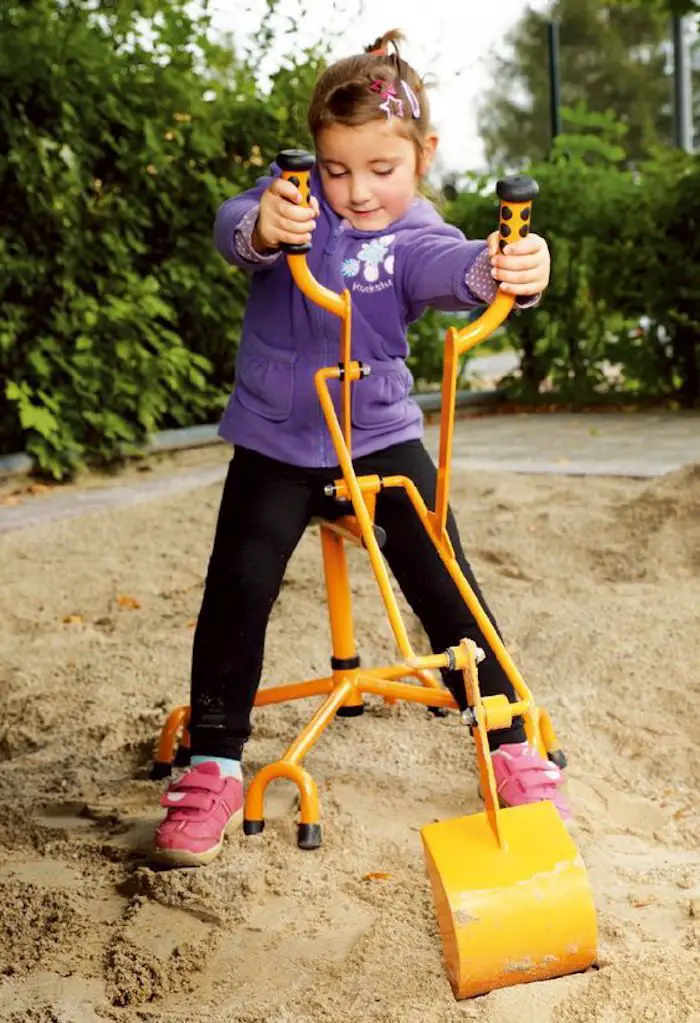
Steps:
Step 1: Prepare the Pallets
Start by disassembling the pallets to extract the wooden boards. These will serve as the primary components of your sandbox excavator. Ensure that the pallet wood is clean, smooth, and free from any nails or debris.
Step 2: Construct the Excavator Arm
Next, assemble the excavator DIY arm using the wooden boards from the pallets. Cut the boards to the desired length, ensuring that they are sturdy enough to support the weight of the excavator bucket. Attach the boards together using waterproof wood glue and reinforce the joints with screws or bolts for added strength.
Step 3: Attach the Galvanized Pipe
Secure the galvanized pipe flange to the end of the sandbox backhoe arm using lag screws or bolts. Thread the 12″ length of threaded galvanized pipe into the flange to create the excavator’s pivot point. This will allow the arm to rotate smoothly as it digs and scoops in the sandbox.
Step 4: Install the Excavator Arm
Mount the excavator arm onto the frame of the cheap office chair using L brackets. Position the arm at a height that allows for easy maneuverability and operation by young excavators. Ensure that the arm is securely attached to the chair frame to prevent any wobbling or instability during play.
Step 5: Add Optional Features
Get creative and add optional features to enhance the functionality and aesthetics of your sandbox excavator. Attach a coil spring to the excavator’s arm to simulate the hydraulic action of a real excavator. You can also incorporate cording to create realistic controls for operating the arm.
Step 6: Paint and Customize
Let your imagination run wild as you paint and customize your sandbox excavator to suit your preferences. Choose a vibrant colour scheme that will captivate young adventurers and transform the ordinary into the extraordinary. Add details such as decals, stickers, or stencilled designs to add personality to your creation.
Step 7: Test and Adjust
Once your sandbox excavator is assembled and painted, it’s time to put it to the test! Set up a sandbox or designated play area and watch as eager hands take control of the excavator arm. Observe how the excavator performs and make any necessary adjustments to ensure optimal functionality and safety.
Step 8: Enjoy Hours of Playtime Fun!
With your DIY sandbox excavator complete, it’s time to sit back and enjoy the fruits of your labour. Watch as children immerse themselves in imaginative play, digging, scooping, and exploring to their heart’s content. Whether it’s building sandcastles, uncovering buried treasures, or simply having a blast in the sandbox, your homemade excavator is sure to provide hours of entertainment and adventure.
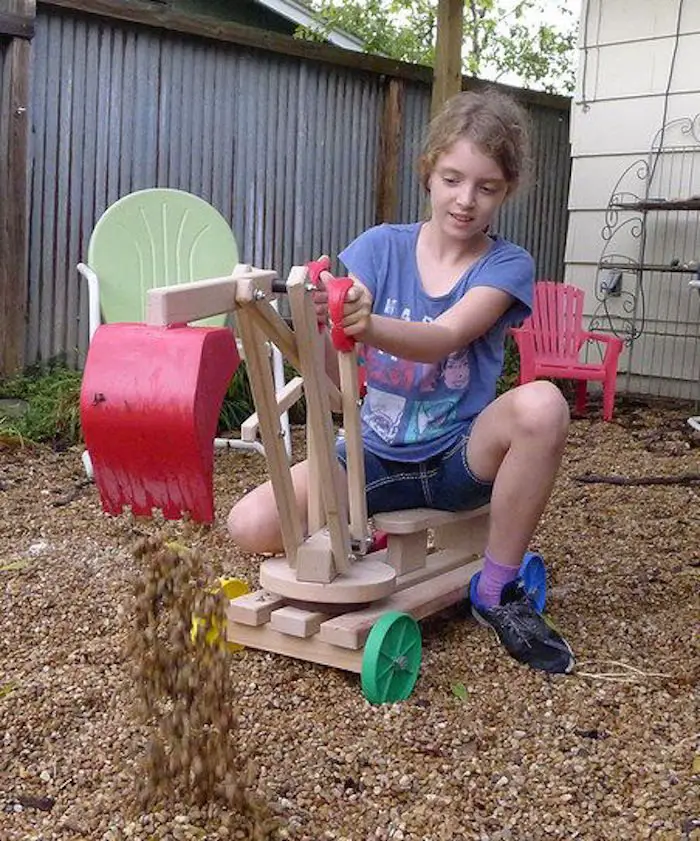
Building a DIY sandbox excavator is not just a construction project—it’s an opportunity to ignite the imagination, foster creativity, and create lasting memories. By transforming simple materials into a captivating playtime experience, you’ll inspire young minds to dream big and explore the world around them.
It might take a while, but this project is definitely worth the work. Thanks to Matt Makes for sharing tips on how to make a DIY sandbox excavator.
Benefits of a Toy Excavator For Sandbox to Kids
Our DIY sandbox was inspired by our desire to connect our children with nature after moving from San Francisco’s urban landscape to Mill Valley’s more serene environment. This new setting offered a unique opportunity for our kids to enjoy the great outdoors every day, which we valued deeply.
With ample stay-at-home time due to recent restrictions, weekends presented the perfect chance for some hands-on family projects. Building a sandbox seemed not just ideal for the children but a fun endeavor for the entire family. We realized we all needed a bit more play and creativity in our lives.
Traditional backyard sandboxes often have a few drawbacks—their basic construction can make them unsightly and prone to damage. We wanted something more durable and visually appealing, so we thought carefully about what elements constitute an exceptional sandbox, taking the time to design and build one that met our standards.
Here’s our journey in constructing a sandbox that excites the kids and contributes to learning and play in the great outdoors.

Wrapping It Up
As we conclude our adventure in crafting a DIY sandbox excavator, it’s clear that this project is more than just a construction endeavour—it’s a gateway to boundless creativity, endless fun, and cherished memories. In just eight exhilarating steps, we’ve transformed basic materials into a captivating playtime experience that sparks the imagination and brings joy to young and old alike.
Through the process of gathering materials, constructing the excavator’s arm, and adding optional features, we’ve unleashed our inner builders and tapped into our ingenuity. We’ve embraced the challenge of problem-solving and the satisfaction of seeing our vision come to life with each screw tightened and board assembled.
As we painted and customized our sandbox excavator, we infused it with personality and character, turning it into a one-of-a-kind masterpiece that reflects our creativity and style. With vibrant colours, playful details, and optional features like coil springs and cording controls, we’ve created a truly unique playtime companion that inspires endless adventures.
Now, as we test and adjust our DIY creation, we witness the joy and excitement it brings to children as they take control of the excavator’s arm and explore the sandbox with boundless enthusiasm. We see their imaginations ignite as they dig, scoop, and discover, transforming the ordinary into the extraordinary with every movement of the arm.
And as we sit back and watch the magic unfold, we’re reminded of the power of DIY craftsmanship to create moments of connection, laughter, and pure joy. Our sandbox excavator isn’t just a toy—it’s a catalyst for adventure, a catalyst for creativity, and a catalyst for memories that will last a lifetime.
So, whether you’re a seasoned DIY enthusiast or a novice builder, I encourage you to embark on your own journey of creativity and discovery. Gather your materials, roll up your sleeves, and let your imagination run wild as you build a DIY sandbox excavator in eight fun-filled steps. The possibilities are endless, and the adventures are waiting—so what are you waiting for? Let’s get building!
FAQ: Toy Excavator for Sandbox
- Is this project suitable for beginners?
- Absolutely! Building a DIY sandbox excavator is a fun and rewarding project that can be enjoyed by beginners and experienced DIY enthusiasts alike. The step-by-step instructions provided in the guide make the process easy to follow, and the materials required are readily available at most hardware stores.
- How long does it take to complete the project?
- The time required to complete the project can vary depending on factors such as your level of experience, the complexity of the design, and the availability of materials. However, most builders can expect to finish the DIY sandbox excavator within a weekend or less, making it a perfect weekend project for the whole family to enjoy.
- Can you customize the design of the sandbox excavator?
- Absolutely! One of the great things about DIY projects is the ability to customize the design to suit your preferences and needs. You can experiment with different colours, shapes, and optional features to create a sandbox excavator that reflects your unique style and personality.
- What age range is the sandbox excavator suitable for?
- The sandbox excavator is designed for children aged 3 and above, but younger children may also enjoy playing with adult supervision. The size and complexity of the excavator arm can be adjusted to accommodate different age groups, ensuring a safe and enjoyable play experience for everyone.
- Do you need any special tools or equipment to build the sandbox excavator?
- While basic woodworking tools such as a saw, drill, hammer, and screwdriver are recommended for this project, no special equipment is required. Most of the materials can be easily cut and assembled using common household tools, making it accessible to builders of all skill levels.
- Is the sandbox excavator safe for children to play with?
- Safety is a top priority when building any DIY project, especially those intended for children. The sandbox excavator is designed with safety in mind, with smooth edges, sturdy construction, and secure fastenings to prevent accidents. However, adult supervision is always recommended, especially for younger children.
- Can you add additional features to the sandbox excavator?
- Add extra features to your sandbox excavator to enhance its functionality and play value. To make the play experience even more exciting for children, you can incorporate features such as a rotating excavator arm, realistic controls, or even a working bucket mechanism.
- Can you build multiple sandbox excavators for a larger play area?
- Yes, you can build multiple sandbox excavators to create a larger play area for children to enjoy. Simply follow the same steps outlined in the guide to construct additional excavators, and arrange them in your desired configuration within the sandbox or play space. This allows multiple children to play together and encourages cooperative play and teamwork.
- What materials are needed to build a DIY sandbox?
- To build a DIY sandbox excavator, gather materials like 1-2 heat-treated pallets, a 3/4″ galvanized pipe flange, a 12″ threaded galvanized pipe, L brackets, waterproof wood glue, and parts from a cheap office chair. Disassemble the pallets to create wooden boards for the excavator arm, attaching them with glue and screws, and secure the galvanized pipe for a pivot point.
- Mount the arm to the chair frame using L brackets, and optionally add features like a coil spring for hydraulic simulation or cording for realistic controls. Finish with paint, decals, and adjustments, transforming simple materials into an engaging playtime experience that fosters creativity and imagination in kids.
- Should a sandbox have a bottom?
- Adding a bottom to a sandbox isn’t mandatory but offers significant benefits. It enhances structural integrity by supporting the frame and helps maintain the sandbox’s shape over time. A base also protects against moisture, rot, grass, and critters, keeping the play area clean and durable. If you choose to include one, use moisture-resistant materials and ensure proper drainage to prevent water accumulation.
- Does a sandpit need drainage?
- Proper drainage is essential for a sandpit to prevent water accumulation, soggy sand, and mold, ensuring a safe and usable play area. Choose a well-draining location with plenty of sunlight to aid evaporation and avoid naturally soggy or flood-prone spots.
- Improve drainage by using an elevated base with gravel, a breathable liner with holes, or a nearby French drain to direct excess water away. Regularly monitor the sandpit for pooling water or wetness, making adjustments as needed to maintain a dry and enjoyable environment.
- How much sand is needed for a 6-foot by 6-foot sandbox?
- To fill a 6-foot by 6-foot sandbox with a standard 6-inch depth of sand, you’ll need about 24 bags of 50-pound play sand. The total volume required is 18 cubic feet, calculated by multiplying the sandbox’s length, width, and depth (6 feet x 6 feet x 0.5 feet). Since each 50-pound bag covers approximately 0.75 cubic feet, dividing the total volume by this amount gives you the number of bags needed. This ensures your sandbox is evenly filled and safe for children to enjoy.
- What are the design principles for building a sandbox?
- To build a standout sandbox, focus on key design principles that ensure durability, functionality, and aesthetic appeal. Use sturdy materials and solid construction techniques to create a resilient structure that withstands wear and tear, providing a safe, long-lasting play area.
- Opt for a spacious layout to encourage group play and foster creativity, making the sandbox a communal hub for kids. Finally, choose natural materials like wood to blend seamlessly with your backyard, creating a sandbox that is both fun and visually harmonious with its surroundings.
- How does the size of a sandbox affect children’s play?
- The size of a sandbox greatly impacts children’s play and interaction. Smaller sandboxes limit space, encouraging individual play over group activities, which can restrict opportunities for social interaction and teamwork.
- Larger sandboxes create a more communal environment, fostering cooperative play, shared creativity, and activities like building castles or digging together. When selecting a sandbox size, balance its dimensions with your available space to ensure it supports group play without overwhelming your yard or play area.
- How durable should a sandbox be?
- A sandbox should be highly durable to withstand years of enthusiastic play and changing weather conditions. Use robust materials like treated wood, sturdy plastic, or metal to ensure resistance against cracking, warping, or breaking.
- Choose weather-resistant materials that can endure UV rays, rain, and snow to maintain the sandbox’s quality and appearance over time. Prioritize a childproof design that can handle rough play while ensuring safety, creating a long-lasting and reliable play area for children.
- Why is it important for a sandbox to fit the context of its environment?
- A sandbox that blends with its environment enhances your outdoor space’s overall aesthetic and harmony. Natural materials like redwood or cedar complement earthy tones and reduce the visual disruption often caused by synthetic designs.
- This integration creates a seamless, immersive play area for children while respecting the surrounding ecosystem and promoting sustainability. Additionally, a well-designed, cohesive backyard can boost your property’s curb appeal and value, making the sandbox a thoughtful and attractive addition.
We have more fun projects your kids will enjoy. Check out our pallet playhouse guide next!





